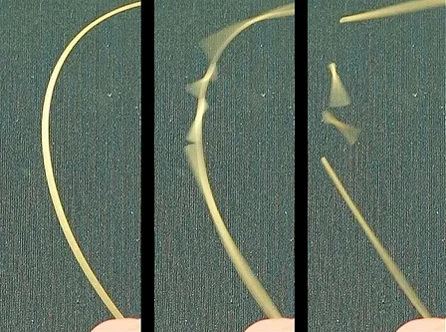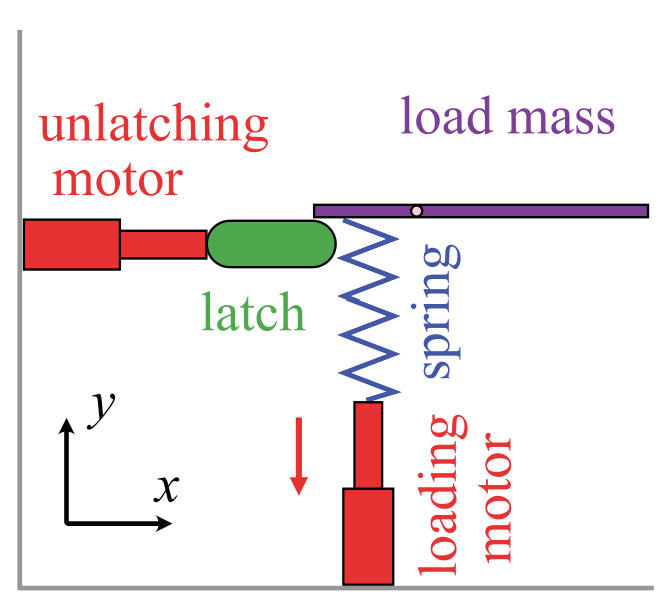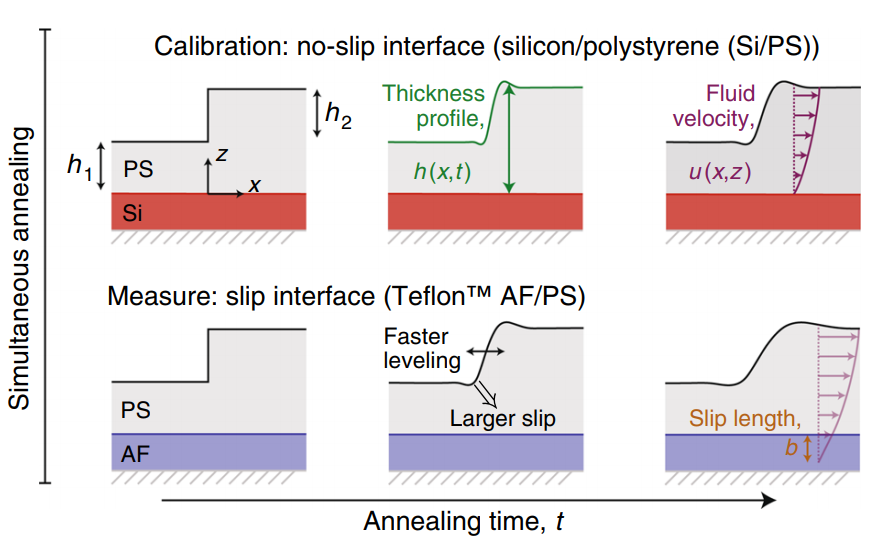
The Physics of Soft Matter Lab at Harvey Mudd College studies the physical principles of soft material deformation
Using both experimental and modeling approaches, we investigate the dynamics of soft elastic solids. Our recent work has been focused on understanding the physical principles of latch-mediated spring actuated (LaMSA) systems, in which springs primarily drive motion. Included in these systems are animals with incredibly fast movements like mantis shrimp and trap-jaw ants. These small animals are able to move at speeds >100km/h and outperform engineered robotic systems. In PoSMLab, we seek to understand the physical principles that enable the rapid motion of biological materials used by these incredible organisms. By understanding these principles behind what these organisms can do, we can use that knowledge to inform future engineering design.
CONTACT
Mark Ilton
Associate Professor
Department of Physics
Harvey Mudd College
milton@hmc.edu
LAB Location
Galileo B101
Harvey Mudd College
301 Platt Blvd.
Claremont, CA 91711






























Current Projects
Developing best-practices to understand the kinematics of fast movements in nature.
Experimental quantification of the rapid movement of elastic materials during unloading using high speed videography.

Publications
Biological springs can be used in nature for energy conservation and ultra-fast motion. The loading and unloading rates of elastic materials can play an important role in determining how the properties of these springs affect movements. We investigate the mechanical energy efficiency of biological springs (American bullfrog plantaris tendons and guinea fowl lateral gastrocnemius tendons) and synthetic elastomers. We measure these materials under symmetric rates (equal loading and unloading durations) and asymmetric rates (unequal loading and unloading durations) using novel dynamic mechanical analysis measurements. We find that mechanical efficiency is highest at symmetric rates and significantly decreases with a larger degree of asymmetry. A generalized one-dimensional Maxwell model with no fitting parameters captures the experimental results based on the independently characterized linear viscoelastic properties of the materials. The model further shows that a broader viscoelastic relaxation spectrum enhances the effect of rate-asymmetry on efficiency. Overall, our study provides valuable insights into the interplay between material properties and unloading dynamics in both biological and synthetic elastic systems.
We develop a model of latch-mediated spring actuated (LaMSA) systems relevant to comparative biomechanics and bioinspired design. The model contains five components: two motors (muscles), a spring, a latch, and a load mass. One motor loads the spring to store elastic energy and the second motor subsequently removes the latch, which releases the spring and causes movement of the load mass. We develop freely available software to accompany the model, which provides an extensible framework for simulating LaMSA systems. Output from the simulation includes information from the loading and release phases of motion, which can be used to calculate kinematic performance metrics that are important for biomechanical function. In parallel, we simulate a comparable, directly actuated system that uses the same motor and mass combinations as the LaMSA simulations. By rapidly iterating through biologically relevant input parameters to the model, simulated kinematic performance differences between LaMSA and directly actuated systems can be used to explore the evolutionary dynamics of biological LaMSA systems and uncover design principles for bioinspired LaMSA systems. As proof of principle of this concept, we compare a LaMSA simulation to a directly actuated simulation that includes either a Hill-type force-velocity trade-off or muscle activation dynamics, or both. For the biologically-relevant range of parameters explored, we find that the muscle force velocity trade-off and muscle activation have similar effects on directly actuated performance. Including both of these dynamic muscle properties increases the accelerated mass range where a LaMSA system outperforms a directly actuated one.
The snap of a finger has been used as a form of communication and music for millennia across human cultures. However, a systematic analysis of the dynamics of this rapid motion has not yet been performed. Using high-speed imaging and force sensors, we analyse the dynamics of the finger snap. We discover that the finger snap achieves peak angular accelerations of 1.6 × 106° s−2 in 7 ms, making it one of the fastest recorded angular accelerations the human body produces (exceeding professional baseball pitches). Our analysis reveals the central role of skin friction in mediating the snap dynamics by acting as a latch to control the resulting high velocities and accelerations. We evaluate the role of this frictional latch experimentally, by covering the thumb and middle finger with different materials to produce different friction coefficients and varying compressibility. In doing so, we reveal that the compressible, frictional latch of the finger pads likely operates in a regime optimally tuned for both friction and compression. We also develop a soft, compressible friction-based latch-mediated spring actuated model to further elucidate the key role of friction and how it interacts with a compressible latch. Our mathematical model reveals that friction plays a dual role in the finger snap, both aiding in force loading and energy storage while hindering energy release. Our work reveals how friction between surfaces can be harnessed as a tunable latch system and provides design insight towards the frictional complexity in many robotic and ultra-fast energy-release structures.
The inherent force–velocity trade-off of muscles and motors can be overcome by instead loading and releasing energy in springs to power extreme movements. A key component of this paradigm is the latch that mediates the release of spring energy to power the motion. Latches have traditionally been considered as switches; they maintain spring compression in one state and allow the spring to release energy without constraint in the other. Using a mathematical model of a simplified contact latch, we reproduce this instantaneous release behaviour and also demonstrate that changing latch parameters (latch release velocity and radius) can reduce and delay the energy released by the spring. We identify a critical threshold between instantaneous and delayed release that depends on the latch, spring, and mass of the system. Systems with stiff springs and small mass can attain a wide range of output performance, including instantaneous behaviour, by changing latch release velocity. We validate this model in both a physical experiment as well as with data from the Dracula ant, Mystrium camillae, and propose that latch release velocity can be used in both engineering and biological systems to control energy output.
Rapid biological movements, such as the extraordinary strikes of mantis shrimp and accelerations of jumping insects, have captivated generations of scientists and engineers. These organisms store energy in elastic structures (e.g. springs) and then rapidly release it using latches, such that movement is driven by the rapid conversion of stored elastic to kinetic energy using springs, with the dynamics of this conversion mediated by latches. Initially drawn to these systems by an interest in the muscle power limits of small jumping insects, biologists established the idea of power amplification, which refers both to a measurement technique and to a conceptual framework defined by the mechanical power output of a system exceeding muscle limits. However, the field of fast elastically driven movements has expanded to encompass diverse biological and synthetic systems that do not have muscles – such as the surface tension catapults of fungal spores and launches of plant seeds. Furthermore, while latches have been recognized as an essential part of many elastic systems, their role in mediating the storage and release of elastic energy from the spring is only now being elucidated. Here, we critically examine the metrics and concepts of power amplification and encourage a framework centered on latch-mediated spring actuation (LaMSA). We emphasize approaches and metrics of LaMSA systems that will forge a pathway toward a principled, interdisciplinary field.
Elastically-driven motion has been used as a strategy to achieve high speeds in small organisms and engineered micro-robotic devices. We examine the size-scaling relations determining the limit of elastic energy release from elastomer bands with mechanical properties similar to the biological protein resilin. The maximum center-of-mass velocity of the elastomer bands was found to be size-scale independent, while smaller bands demonstrated larger accelerations and shorter durations of elastic energy release. Scaling relationships determined from these measurements are consistent with the performance of small organisms which utilize elastic elements to power motion. Engineered devices found in the literature do not follow the same size-scaling relationships, which suggests an opportunity for improved design of engineered devices.
In biological and engineered systems, an inherent trade-off exists between the force and velocity that can be delivered by a muscle, spring, or combination of the two. However, one can amplify the maximum throwing power of an arm by storing the energy in a bow or sling shot with a latch mechanism for sudden release. Ilton et al. used modeling to explore the performance of motor-driven versus spring-latch systems in engineering and biology across size scales. They found a range of general principles that are common to animals, plants, fungi, and machines that use elastic structures to maximize kinetic energy.
Hydrodynamic slip, the motion of a liquid along a solid surface, represents a fundamental phenomenon in fluid dynamics that governs liquid transport at small scales. For polymeric liquids, de Gennes predicted that the Navier boundary condition together with polymer reptation implies extraordinarily large interfacial slip for entangled polymer melts on ideal surfaces; this Navier-de Gennes model was confirmed using dewetting experiments on ultra-smooth, low-energy substrates. Here, we use capillary leveling—surface tension driven flow of films with initially non-uniform thickness—of polymeric films on these same substrates. Measurement of the slip length from a robust one parameter fit to a lubrication model is achieved. We show that at the low shear rates involved in leveling experiments as compared to dewetting ones, the employed substrates can no longer be considered ideal. The data is instead consistent with a model that includes physical adsorption of polymer chains at the solid/liquid interface.

PEOPLE
Lucien (Physics '24) is a current graduate student at Glaucio Paulino's lab at Princeton University working on Origami Engineering. You will likely see Lucien walking up mountains, swinging wooden sticks, or surviving underwater, but you will always see him drinking Coca-Cola.
Leila ('26) is a prospective biophysics major doing polymer physics research with the materials team. She is currently working on bottlebrush rheology and has a strong interest in interdisciplinary science. In her free time she enjoys hiking, painting, and stargazing.
Taylor (HMC '25) is a rising junior computer science major from just outside Philadelphia. In addition to computer science, Taylor has a strong interest in mechanical and materials engineering. For PoSM Lab, she is working on analyzing how tendons with different functions respond to the same types of mechanical tests. She enjoys music, theater, over analyzing movies and tv-shows, and spending time with her dogs.
Sophie Poole (HMC 25’) is a rising junior and is majoring in Computer Science and Math. She loves musicals, computer graphics/animation, scuba diving, and her dogs. She has previously worked in Cathy McFadden’s lab researching Octocorals at Mudd. She’s excited to keep the ocean theme going by working on Mantis Shrimp with the PoSM lab.
Dalton (HMC '25) is from Boulder Colorado. He is majoring in Engineering with a particular interest in Aerospace, but an interest in basically any type of engineering project. On the PoSM Lab team, he is working on researching how scaling affects LaMSA systems, and redesigning the instrumentation for the lab's recoil testing machine. He enjoys hiking, Formula 1, and Hip Hop in his free time.
Martin (’25) is a junior engineering major at Harvey Mudd College. He is interested in robotic mechanisms and electrical engineering. As a member of the robotic subgroup, Martin focuses on designing and improving small-scale jumping robot, Universal Testing Machine and spring-powered robot dog. He has a great interests in physics and believe that engineering skills have great help in the lab. He loves games, movies and anime.
Jadyn ('26) is a member of the PoSM Lab materials team! Although she's focusing on computer science and theatre, physics brings her a lot of joy. She loves musical theatre, Dungeons & Dragons, pandas, and hand-drawn animation.
Caetano Pérez-Marchant (class of 2024) comes from Santa Barbara, California, and began pursuing an undergraduate degree in chemistry at Harvey Mudd College. Although Caetano is open to studying all forms of chemistry, his current trajectory is headed towards polymer and material science. Caetano joined PoSM lab during the 2022-2023 academic year and summer of 2023 as part of the materials sub-team. At the moment he studies the rheology of a specific elastomer while altering its composition. His interests include running, science fiction novels, dishes containing grilled salmon, the tabletop game Dungeons and Dragons, and skeletons. He promises the last item on that list is not weird and should not be cause for concern.
Ingrid (‘23) is a rising first-year graduate student at MIT MERS lab. She graduated with Computer Science department at HMC, and she holds a strong interest in physics. As a member of biomaterials team in PoSM lab, she aims to improve existing mathematical models of mantis shrimp strikes to have a better understandings of physics involved in animals of small scales.
James Clinton is a sophomore engineering major at Harvey Mudd College. His academic interests are centered on designing and studying robotic mechanisms and systems. In the posmlab, James is currently working on analyzing the performance of robotic jumpers, and designing a spring-powered robot dog. In his free time, James enjoys playing viola, working in the machine shop, and building 3D printers.
After recently joining the Department of Physics at HMC in 2018, Prof. Ilton is seeking curious and enthusiastic students interested in Soft Matter and Biomechanics to join the PoSM Lab. When not in the classroom or lab, you will likely find him in the yoga studio, biking around town, or relaxing in the back yard.
Paco Navarro (‘25) is from Minneapolis Minnesota!
Paco is majoring in Physics and Math with an emphasis in environmental analysis. He races bikes, loves to cook, and sing! You’ll more than likely find him outside, even if it’s -40 or he’s sleeping :)
Ross is a junior studying engineering at HMC. His research interests include physiology, ecology, and learning about the ways in which biological systems have adapted to efficiently interact with their environment. He is most interested in the intersection of engineering and biology. Outside of class, if he is not watching movies, reading, or playing video games, he is probably asleep.
Vanessa Bartling is a freshman at Harvey Mudd College. Her intended major is engineering with a concentration in economics. She is part of the materials subgroup in the posm lab. Vanessa has entrepreneurial ambitions related to wearable technology and smart textiles. She plays the drum set in different jazz groups and designs and sews clothing
Alex Schlegel hails from the Washington D.C. area, where he developed an interest in physics, particularly mechanics, after being punched by a radioactive mantis shrimp. A physics major (class of 2023) at Harvey Mudd College, he hasn't quite nailed down what he wants to do with his life yet, but is sure that it will involve physics in some capacity and is hopeful that it will allow for him to keep learning. His interests include good books, bad movies, card games for nerds, and hoping in vain that society as we know it will wait to collapse until after he's dead.
Kaeshav (’24) is a Math-Physics major working in the modeling team at PoSMLab. He joined in Spring 2022 and is currently using computer simulations to understand how elastic materials store and release energy. Outside of research, he enjoys reading, gardening, and photography.
Lauren Henson (she/they) is a rising junior at Mudd, and is pursuing an undergraduate degree in physics (with an emphasis in astrophysics). Lauren joined PoSM lab in the summer of 2022, and will be working on the lab’s modeling team. They look forward to learning more about mantis shrimp and bio-elastic materials along the way. In the future, Lauren plans to pursue a Ph.D. in astrophysics, hopefully specializing in galactic origins and evolution (though that is subject to change). In their free time, Lauren likes to sketch, hang out with friends, and play with their two cats, Rosie and Sugar.
Amber (‘24) is an engineering major at Mudd. They are interested in mechanical design, bioinspired design, and robotic systems. In the lab, they work on the robotics subteam and are investigating ways to make the LaMSA (latch-mediated spring actuated) system more efficient.
Tanvi is a sophomore at HMC majoring in Physics and CS (IPS). She is currently studying performance tradeoffs in a LaMSA robotic jumper, and is also interested in computational physics. Outside of research, she enjoys crocheting and baking!
Avalon is a senior physics major and is completing their thesis in the lab after two summers of on-campus materials science research. Her thesis explores the effect on energy efficiency of elastomers, both synthetic and biological, under asymmetric loading and unloading times. Outside of the lab, they enjoy watching movies with friends, doing puzzles of all kinds, and spending time with her cat, Dante.
Andrew is doing a thesis on simulation of viscoelastic recoil. They like making plots pretty at the expense of clarity. In their free time, they enjoy playing FFXIV and drawing bunnies.
Halie is an engineering major at Harvey Mudd, class of 2022, originally from San Francisco. She joined PoSM Lab in the spring of 2021.
Halie is interested in materials development, sustainability, and bio-inspired engineering! She worked on the joint cone snail project with the Mendelson FILM Lab in the engineering department over the spring of 2021, and transitioned to the Materials subteam for the summer of 2021, where she worked with Carolyn on developing procedures for synthesizing polydimethylsiloxane (PDMS) polymers in the lab. She is excited for PoSM Lab to create our own polymers with customizable material properties!
Halie really enjoys collecting stickers and bullet journaling, and is an avid reader of Webtoons. She is always down to talk about cool animal facts and model organisms!
Andrés is a sophomore at HMC. He is currently investigating how organisms use elastic materials to store and release energy, but is generally interested in mathematically modeling living systems. Outside of class, he enjoys watching TV and playing board games with his friends.
Nick Heller is a sophomore in physics at HMC. His research interests include biophysics, particle physics, and renewable energy. He also has a keen interest for interdisciplinary problems in physics. Outside of physics, Nick enjoys climbing mountains and playing the piano.
A first-year student at HMC, Winnie’s research interests include environmental science and green technologies. She is especially interested in how ecology and climate change intersect. Outside of research, she enjoys oil painting and gardening!

Join Us
PoSM Lab is looking for new members! Please fill out the form below if you are interested and would like to know more.


































